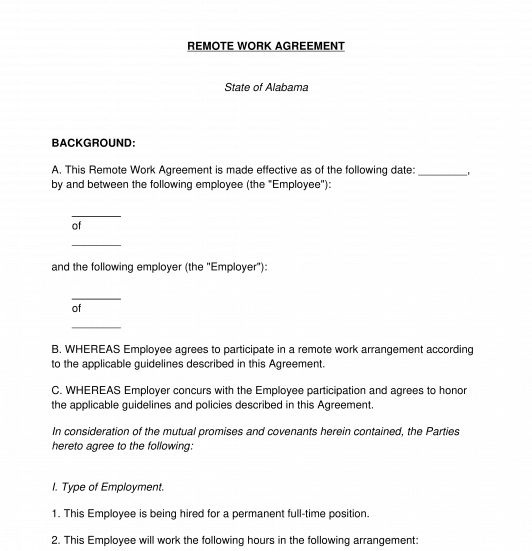 01/02/2024
01/02/2024

Answer a few questions and your document is created automatically.

Your document is ready! You will receive it in Word and PDF formats. You will be able to modify it.




Rating: 4.6 - 23 votes
Fill out the templateA Remote Work Agreement (sometimes known as a Telecommuting Agreement) is a document used by employees and employers, to define their respective rights and responsibilities at the start of an employment arrangement where the employee works remotely under the employer's work from home policy.
More and more often, employers are realizing that letting employee's work outside of the office leads to increased productivity and enhances the employee's quality of life. However, there are some specific issues with remote work that should be addressed in the employment contract. The document allows the employer to make their expectations for the remote work set-up clear and known to the employee, which helps the parties avoid future confusion or dispute.
This website also has a more general-purpose employment agreement that can be used for non-remote work employment arrangements. For more information about employee and employer relationships and how they differ from freelancer or independent contractor arrangements, please see the guide "What's the Difference Between an Employee and an Independent Contractor?"
How to use this document
Although a Remote Work Agreement can be as basic or detailed as the parties desire, this Agreement includes essential information including the names and addresses of the parties, as well as a detailed description of the rights and responsibilities of the employee. Importantly, the Agreement specifies the type of employment arrangement that the employer and employee are creating, whether it is full-time or part-time, indefinite or fixed. Specific to remote work situations, in addition to describing the employee's job title and responsibilities, this Agreement also allows the parties to define the employee's work schedule. In this section, the parties should describe how many days per week the employee is allowed to work remotely, the hours during which they should be working and available to the employer, and other expectations about when and how the work should happen that must be made clear to the employee before the job begins.
Commonly in remote work situations, the employer is provided with equipment that they will use to complete their work outside of the office, such as company-issued phones, laptops, or headsets. This Agreement describes what kinds of equipment that the employer will give to the employee and the employee's responsibility to maintain this equipment in good working condition and return to the employer at the termination of this Agreement. Further, employers often need the option to inspect the employee's remote work site to make sure that it is properly equipped for the employee to correctly complete their work. This Agreement allows employers to have this option and gives employees a certain amount of notice before one of these inspections happens.
Along with details specific to remote work, this Agreement also includes more general details that apply to all employment agreements, including compensation, overtime, benefits, vacation days, and performance reviews. These details further help the employer and employee clarify the contours of their working relationship.
Once the parties complete this Agreement, they should both print it out, sign it, and retain copies for their own records.
Applicable law
Employment and employment agreements in the United States are subject to both federal laws and specific state laws. For example, the federal Fair Labor Standards Act (FLSA) covers wages and overtime pay for certain sectors. State laws, however, may define and restrict how employers can protect themselves if an employee tries to take their clients or use confidential information.
How to modify the template
You fill out a form. The document is created before your eyes as you respond to the questions.
At the end, you receive it in Word and PDF formats. You can modify it and reuse it.
A guide to help you: Important Considerations for your Employment Agreement
Other names for the document:
Remote Employee Agreement, Tele-Commute Agreement, Telecommute Agreement, Telecommuting Agreement, Telework Agreement
Country: United States